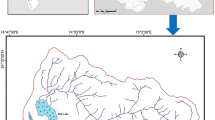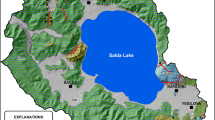Abstract
The chemistry of major elements (Ca, Mg, Na, K and Si) and anions (HCO3, SO4 and Cl) in the water of Mansar Lake was studied, based on seasonal data. The results show that total dissolved solid (TDS) concentration in a particular season is similar, but varies slightly in different seasons with a variation factor of less than 2. This is because the collections were made in the dry seasons and the Ca-precipitation is the cause for the seasonal variability. The major element chemistry of Mansar Lake is mainly controlled by rock weathering, with HCO3 and Ca dominating the major ion composition because of the abundance of carbonate rocks in the basin. The results also indicate that the lake water is saturated with respect to calcite and/or dolomite during the spring season whereas it is undersaturated in the summer season. This contrast brings out seasonal variability. The lake shows disequilibrium with atmospheric CO2 as a result of carbonate dissolution in the drainage basin. The study also shows that physical weathering/erosion is dominant and that chemical weathering is incipient. This is consistent with the Chemical Index of Alteration (CIA) data.








Similar content being viewed by others
References
Abbas N, Subramanian V (1984) Erosion and sediment transport in the Ganges River basin, India. J Hydrol 69:173–182
Allen PA, Collinson JD (1986) Lakes. In: Reading HG (ed) Sedimentary environment and facies. Blackwell, Oxford, pp 63–94
Al-Mikhlafi AS (2001) Water and sediment geochemistry of Mansar Lake, Jammu, India: with reference to environmental problems. PhD Thesis, Faculty of Science, Panjab University, Chandigarh
Appelo CA, Postma D (1993) Geochemistry, groundwater and pollution. Balkema, Rotterdam
Berner EK, Berner RA (1987) The global water cycle. Prentice-Hall, Englewood Cliffs
Berner EK, Berner RA (1996) Global environmental: water, air and geochemical cycles. Prentice-Hall, Englewood Cliffs
Bricker OP, Rice KC (1989) Acid deposition to streams: a geology based method predicts their sensitivity. Environ Sci Technol 23:379–485
Clark FW (1924) The data of geochemistry. US Geol Survey Prof Paper 770
Das BK, Kakar RK (2000) Major ion chemistry and weathering processes of the Mansar Lake, sub-Himalaya. Jammu, India. J Panjab Acad Sci II:241–247
Drever JI (1997) The geochemistry of natural waters, 3rd edn. Prentice-Hall, Upper Saddle River
Gaillardet J, Dupre B, Louvat P, Allegre JC (1999) Global silicate weathering and CO2 consumption rates deduced from the chemistry of large rivers. Chem Geol 159:3–30
Galy A, France-Lanord C (1999) Weathering processes in the Ganges–Brahmaputra basin and the riverine alkalinity budget. Chem Geol 159:31–60
Garrels RM, Christ CL (1965) Solutions, minerals and equilibria. Freeman Cooper, San Francisco
Garrels RM, Mackenzie FT (1971) Evolution of sedimentary rocks. Norton, New York
Gibbs RJ (1970) Mechanism controlling world water chemistry. Science 170:1088–1090
Hem JD (1985) Study and interpretation of the chemical characteristics of natural water. US Water-Supply Paper 2254
Holland HD (1978) The chemistry of oceans and atmosphere. Wiley, New York
Jones BF, Bowser CJ (1978) The mineralogy and related chemistry of lake sediments. In: Lerman A (ed) Lakes: chemistry, geology, physics. Springer, Berlin Heidelberg New York, pp 179–235
Junge C (1972) Our knowledge of the physico-chemistry of aerosols in the undisturbed marine environment. J Geophys Res 77:5183–5200
Meybeck M (1981) Pathways of major elements from land to ocean through rivers. In: Martin J-M, Burton JD, Eisma D (eds) River inputs to ocean systems. UNEP/UNESCO, Paris, pp 18–30
Meybeck M (1987) Global chemical weathering of surficial rocks estimated from river dissolved loads. Am J Sci 287:401–428
Negrel P, Allegre CJ, Dupre B, Lewin E (1993) Erosion sources determined by inversion of major and trace element ratios in river water: the Congo Basin case. Earth Planet Sci Lett 120:59–76
Pande K, Sarin MM, Trivedi JR, Krishnaswami S, Sharma KK (1994) The Indus River system (India–Pakistan). Major-ion chemistry, uranium and strontium isotopes. Chem Geol 116:245–259
Piper AM (1944) A graphic procedure in the geochemical, interpretation of water analysis. Am Geophys Union Trans 25:914–923
Sarin MM, Krishnaswami S, Dilli K, Somayajulu BLK, Moore WS (1989) Major ion chemistry of the Ganga–Brahmaputra River system: weathering processes and fluxes to the Bay of Bengal. Geochim Cosmochim Acta 53:997–1009
Singh R, Sharma VK (1999) Geoenvironmental appraisal of Mansar and Surinsar Lakes, Udhampur and Jammu districts .Geol Surv India Records 131:19–24
Stallard RF (1980) Major element geochemistry of the Amazon River system. PhD Thesis, Massachusetts Institute of Technology
Stallard RF, Edmond JM (1981) Geochemistry of the Amazon: 1. Precipitation chemistry and the marine contribution to the dissolved load at the time of peak discharge. J Geophys Res 86:9844–9858
Stallard RF, Edmond JM (1983) Geochemistry of Amazon: 2. The influence of geology and weathering environment on the dissolved load. J Geophys Res 88:9671–9688
Stallard RF, Edmond JM (1987) Geochemistry of the Amazon: 3. Weathering chemistry and limits to dissolved inputs. J Geophys Res 92:8293–8302
Stumm W (1992) Chemistry of the solid–water interface. Wiley, New York
Taylor SR, McLennan SM (1985) The continental crust: its composition and evolution. Blackwell, Oxford
Trescases JJ (1992) Chemical weathering. In: Butt CRM, Zeegers H (eds) Regolith exploration geochemistry in tropical and subtropical terrains, handbook of geochemistry. Elsevier, Amsterdam, pp 25–40
Zhang J, Huang WW, Letolle R, Jusserand C (1995) Major element chemistry of the Huanghe (Yellow River), China: weathering processes and chemical fluxes. J Hydrol 168:173–203
Acknowledgements
This research received financial support from Department of Science and Technology, the Government of India, under a research project (ES/23/186/93) awarded to B.K.D, which is thankfully acknowledged. The authors are thankful to the anonymous referees for their suggestions.
Author information
Authors and Affiliations
Corresponding author
Rights and permissions
About this article
Cite this article
Al-Mikhlafi, A.S., Das, B.K. & Kaur, P. Water chemistry of Mansar Lake (India): an indication of source area weathering and seasonal variability. Env Geol 44, 645–653 (2003). https://doi.org/10.1007/s00254-003-0798-x
Received:
Accepted:
Published:
Issue Date:
DOI: https://doi.org/10.1007/s00254-003-0798-x




